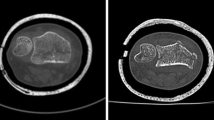Abstract
The aim of this study was to compare low-field MRI (0.2 T) and conventional radiography for the detection of acute fractures of the distal part of the extremities. X-ray and MRI examinations of 78 (41 fractures, 37 without fracture) patients with the clinical suspicion of an acute fracture in the distal part of the extremities were compared. Four experienced radiologists, two for each of the two modalities, independently analyzed the images. Interobserver variability and receiver operating characteristic (ROC) analysis for both methods were established. The MRI and conventional radiography revealed an accuracy of 81.4 and of 79.5%, respectively, in the detection of acute fractures. The diagnostic accuracy of MRI to detect fractures in the hand and forefoot proved to be significantly inferior to conventional X-ray examinations. On the other hand, MRI achieved a better accuracy for the examination of bones near a large joint. The interobserver variability for both methods was rated as moderate. In ROC analysis both methods were rated as good. There was no statistical difference of the accuracy between low-field MRI and conventional radiography in the detection of acute fractures of the distal part of the extremities. Consequently, a routine use of low-field MRI as an alternative to conventional radiography to diagnose acute fractures of the extremities seems not to be justified.




Similar content being viewed by others
References
Masciocchi C, Barile A, Satragno L (2000) Musculoskeletal MRI: dedicated systems. Eur Radiol 10:250–255
Peterfy CG, Roberts T, Genant HK (1998) Dedicated extremity MR imaging: an emerging technology. Magn Reson Imaging Clin N Am 6:849–870
Bohndorf K (1999) Imaging of acute injuries of the articular surfaces (chondral, osteochondral and subchondral fractures). Skeletal Radiol 28:545–560
Bertlau T, Christensen OM, Edstrom P, Thomsen HS, Lausten GS (1999) Diagnosis of scaphoid fracture and dedicated extremity MRI. Acta Orthop Scand 70:504–508
Kesting-Sommerhoff B, Gerhardt P, Golder W, Hof H, Riel KA, Helmberger H, Lenz M, Lehner K (1995) MRT des kniegelenks: erste ergebnisse eines vergleichs von 0.2 T spezialsystem mit 1.5 T hochfeldmagnet. RöFo 162:390–395
Klein MA (1993) Reformatted three dimensional fourier transformed gradient-recalled-echo MR imaging of the ankle: spectrum of normal and abnormal findings. Am J Roentgenol 161:831–836
Schick S, Tratting S, Gabler C, Kukla C, Gahleitner A, Kainberger F, Ba-Ssalamah A, Breitenseher M (1999) Okkulte handgelenksfrakturen: feinfokusvergrösserungsröntgen vs MRT. Röfo 170:16–21
Metz CE (1978) Basic principles of ROC analysis. Semin Nucl Med 8:283–298
Hanley JA, McNeil BJ (1982) The meaning and use of the area under receiver operating characteristic curve. Radiology 143:29–36
Hanley JA, McNeil BJ (1983) The method of comparing the area under the receiver operating characteristic curves derived from the same case. Radiology 148:839–843
Brennan P, Silman A (1992) Statistical methods for assessing observer variability in clinical measures. Br Med J 304:1491–1494
Haramati N, Staron RB, Barax C, Feldman F (1994) Magnetic resonance imaging of occult fractures of the proximal femur. Skeletal Radiol 23:19–22
Kersting-Sommerhoff B, Hof N, Lenz M, Gerhardt P (1996) MRI of the peripheral joints with a low-field dedicated system: a reliable and cost-effective alternative to high-field units? Eur Radiol 6:561–565
Riel KA, Martinek V, Öttl G, Reinisch M, Lehner K, Gerhard P, Hipp E (1993) Kernspintomographie (MRT). Befunde bei Sportverletzungen am oberen Sprunggelenk. Sportorthop Sporttraumatol 12:126–130
Munk PL, Lee MJ, Logan PM, Connell DG, Janzen DL, Poon PY (1997) Scaphoid bone waist fractures, acute and chronic: imaging with different techniques. Am J Roentgenol 168:779–786
Bonel H, Frick A, Sittek H, Heuck A, Steinborn M, Baumeister RG, Reiser M (1997) Untersuchung von hand und handgelenken mit einem dedizierten Niederfeldextremitäten-MRT-Gerät. Radiologe 37:785–793
Fowler C, Sullivan B, Williams LA, McCathy G, Savage R, Palmer A (1998) A comparison of bone scintigraphy and MRI in the early diagnosis of occult scaphoid fracture. Skeletal Radiol 27:683–687
Gaebler C, Kukla C, Breitenseher M, Trattning S, Mittlboeck M, Vecsei V (1996) Magnetic resonance imaging of occult scaphoid fractures. J Trauma 41:73–76
Hunter JC, Escobedo EM, Wilson AJ, Hanel DP, Zink-Brody GC, Mann FA (1997) MR imaging of clinically suspected scaphoid fractures. Am J Roentgenol 168:1287–1293
Lepistö J, Mattila K, Nieminen S, Sattler B, Kormano M (1995) Low-field MRI and scaphoid fracture. J Hand Surg 20:539–542
Bohndorf K, Kilcoyne RF (2002) Traumatic injuries: imaging of peripheral musculoskeletal injuries. Eur Radiol 12:1605–1616
Breitenseher MJ, Metz MV, Gilula LA, Gaebler C (1997) Radiographically occult scaphoid fractures: value of MR imaging in detection. Radiology 203:245–250
Hilfiker P, Zanetti M, Debatin JF, McKinnon G, Hodler J (1995) Fast spin-echo inversion-recovery imaging vs fast T2-weighted spin-echo imaging in bone marrow abnormalities. Invest Radiol 30:110–114
Hottya GA, Häckl FO, Iwasko NG, Weber E, White D, Steinbach LS, Peterfy CG, Genant HK (2000) Assessing radiographically occult upper extremity fractures with dedicated extremity MRI. Emerg Radiol 7:339–348
Van Gelderen WF, al-Hindawi M, Gale RS, Steward AH, Archibald CG (1997) Significance of short tau inversion recovery magnetic resonance sequence in the management of skeletal injuries. Australas Radiol 41:13–15
Bertlau T, Tuxoe J, Larsen L (2002) Bone bruise in the acutely injured knee. Knee Surg Sports Traumatol Arthrosc 10:96–100
Author information
Authors and Affiliations
Corresponding author
Rights and permissions
About this article
Cite this article
Remplik, P., Stäbler, A., Merl, T. et al. Diagnosis of acute fractures of the extremities: comparison of low-field MRI and conventional radiography. Eur Radiol 14, 625–630 (2004). https://doi.org/10.1007/s00330-003-2066-6
Received:
Revised:
Accepted:
Published:
Issue Date:
DOI: https://doi.org/10.1007/s00330-003-2066-6




